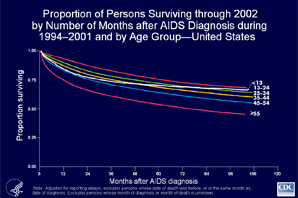|
|
|
|
|
|
||
|
Divisions of HIV/AIDS Prevention |
|||||||
| Slide Sets | Home | Index | Search | Site Map | Subscribe | Contact Us |
HIV/AIDS Surveillance - General Epidemiology
L178 slide series
(through 2002)
Download complete set (28 slides) in PDF format (Adobe Acrobat v5.0 or higher) - (733 KB)
Download complete set (28 slides) in PPT format (PowerPoint 2002 required) - (1,384 KB)
While the content is in the
public domain and no copyright
restriction applies,
we do ask that users preserve the slides in their current
format and cite CDC as the source.
See "Instructions for Downloading and
Using HIV/AIDS surveillance slides".
Adobe Acrobat (TM) Reader v5.0 or higher needs to be installed
on your computer
in order to be able to read the slides in Adobe PDF (Portable Document Format).
Download the Adobe
Acrobat (TM) Reader
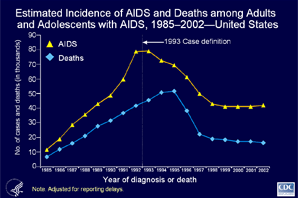 |
 |
| Slide 1 Estimated Incidence of AIDS and Deaths of Adults and Adolescents with AIDS, 1985 - 2002, United States |
Slide 2 AIDS Cases and Deaths Reported through 2002—United States |
| Zoom/Download Slide 1 | Zoom/Download Slide 2 |
 |
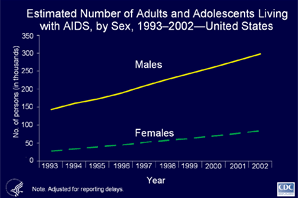 |
| Slide 3 Persons Diagnosed with AIDS, by Age and Sex, Reported through 2002—United States |
Slide 4 Estimated Number of Adults and Adolescents Living with AIDS, by Sex, 1993–2002—United States |
| Zoom/Download Slide 3 | Zoom/Download Slide 4 |
 |
 |
| Slide 5 Estimated Number of Persons Living with AIDS by Race/Ethnicity, 1993–2002—United States |
Slide 6 Estimated Number of Asians/Pacific Islanders and of American Indians/Alaska Natives Living with AIDS 1993–2002—United States |
| Zoom/Download Slide 5 | Zoom/Download Slide 6 |
 |
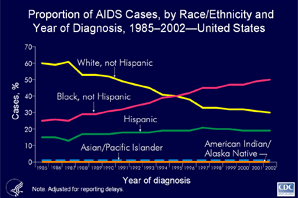 |
| Slide 7 Estimated Number of Persons Living with AIDS, by Region 1993–2002—United States |
Slide 8 Proportion of AIDS Cases, by Race/Ethnicity and Year of Diagnosis, 1985–2002—United States |
| Zoom/Download Slide 7 | Zoom/Download Slide 8 |
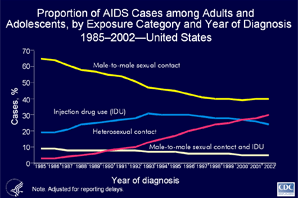 |
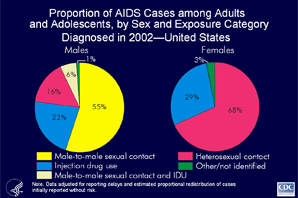 |
| Slide 9 Proportion of AIDS Cases among Adults and Adolescents, by Exposure Category and Year of Diagnosis 1985–2002 United States |
Slide 10 Proportion of AIDS Cases among Adults and Adolescents, by Sex and Exposure Category Diagnosed in 2002—United States |
| Zoom/Download Slide 9 | Zoom/Download Slide 10 |
 |
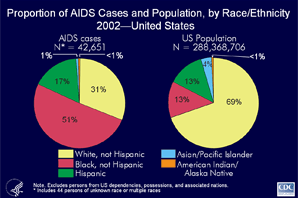 |
| Slide 11 AIDS Rates, Reported in 2002—United States |
Slide 12 Proportion of AIDS Cases and Population, by Race/Ethnicity 2002—United States |
| Zoom/Download Slide 11 | Zoom/Download Slide 12 |
 |
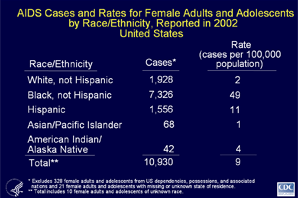 |
| Slide 13 AIDS Cases and Rates for Male Adults and Adolescents by Race/Ethnicity, Reported in 2002 United States |
Slide 14 AIDS Cases and Rates for Female Adults and Adolescents by Race/Ethnicity, Reported in 2002 United States |
| Zoom/Download Slide 13 | Zoom/Download Slide 14 |
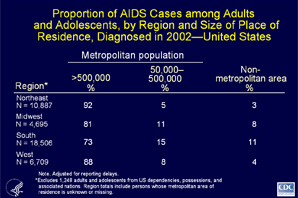 |
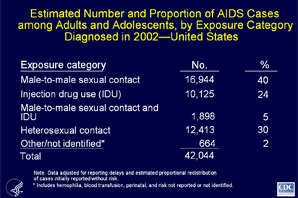 |
| Slide 15 Proportion of AIDS Cases among Adults and Adolescents, by Region and Size of Place of Residence, Diagnosed in 2002—United States |
Slide 16 Estimated Number and Proportion of AIDS Cases among Adults and Adolescents, by Exposure Category Diagnosed in 2002—United States |
| Zoom/Download Slide 15 | Zoom/Download Slide 16 |
 |
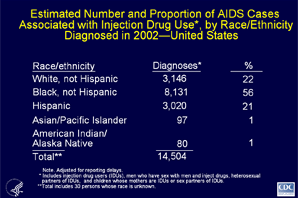 |
| Slide 17 Estimated Number and Proportion of AIDS Cases Associated with Injection Drug Use, by Exposure Category Diagnosed in 2002—United States |
Slide 18 Estimated Number and Proportion of AIDS Cases Associated with Injection Drug Use, by Race/Ethnicity Diagnosed in 2002—United States |
| Zoom/Download Slide 17 | Zoom/Download Slide 18 |
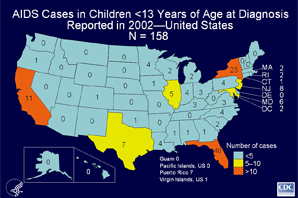 |
 |
| Slide 19 AIDS Cases in Children, Reported in 2001 |
Slide 20 Year of Initiation of Confidential HIV Case Surveillance, as of April 2002 |
| Zoom/Download Slide 19 | Zoom/Download Slide 20 |
 |
 |
| Slide 21 Cases of HIV Infection (not AIDS), Reported in 2002 |
Slide 22 Adolescents 13–19 Years of Age Living with HIV Infection (not AIDS) or with AIDS, Reported through 2002 |
| Zoom/Download Slide 21 | Zoom/Download Slide 22 |
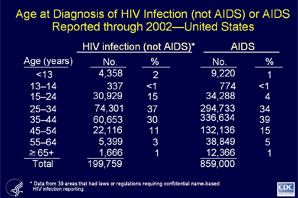 |
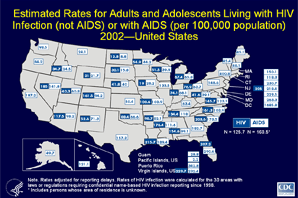 |
| Slide 23 Age at Diagnosis of HIV Infection (not AIDS) or AIDS Reported through 2002—United States |
Slide 24 Estimated Rates for Adults and Adolescents Living with HIV Infection (not AIDS) or with AIDS (per 100,000 population) 2002—United States |
| Zoom/Download Slide 23 | Zoom/Download Slide 24 |
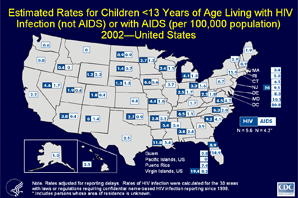 |
 |
| Slide 25 Estimated Rates for Children <13 years of Age Living with HIV Infection (not AIDS) or with AIDS (per 100,000 population) 2002—United States |
Slide 26 Proportion of Persons Surviving through 2002 by Number of Months after AIDS Diagnosis during 1994–2001 and by Year of Diagnosis—United States |
| Zoom/Download Slide 25 | Zoom/Download Slide 26 |
|


